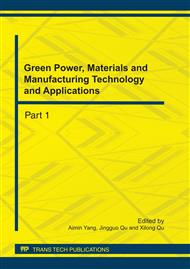[1]
MIN Gui-rong and GUO Shun: Space thermal control [M ]. Beijing: Science Press, (1998).
Google Scholar
[2]
Maria B, Geoffrey L and H, Richard K: Titanium-aluminum-nitride coatings for satellite temperature control[J]. Thin Solid Films. 2000, 370: 268-277.
DOI: 10.1016/s0040-6090(00)00914-7
Google Scholar
[3]
Theodore D and Swanson, G C: NASA thermal control technologies for robotic spacecraft[J]. Applied Thermal Engineering, 2003(23): 1055-1065.
DOI: 10.1016/s1359-4311(03)00036-x
Google Scholar
[4]
Joseph A. W. Challenges and opportunities for the more electric aircraft. presentation on purdue university[J]. West Lafayette, 2004(4): 125-130.
Google Scholar
[5]
LIU Jie, PEI Nian-qiang and GUO Kai-hua : Experimental investigation on startup of a novel two-phase cooling loop[J]. Experimental Thermal and Fluid Science . 2008, 32(4): 939-946.
DOI: 10.1016/j.expthermflusci.2007.10.010
Google Scholar
[6]
LIUJie, PEI Nin-qiang and GUO Kaihua : Experimental study on superheat phenomena of two-phase mechanically pumped cooling loop [J]. 2007, 46(6): 25-29.
Google Scholar
[7]
Gnielinski V: New equations for heat and mass transfer in turbulent pipe and channel flow [J]. Int. Chem. Eng. 1976, 16: 359-368.
Google Scholar
[8]
Dittus, F. W. Boelter and L. M. K.: Heat transfer in automobile radiators of the tubular type [J]. University of California Publications in Engineering. 1930, 2: 443-461.
Google Scholar
[9]
McAdams and W. H: Heat Transmission[M]. 2nd edn. McGraw-Hill, New York. 1942: 215-221.
Google Scholar
[10]
YANG Pei-zhi and CHEN Huan-xin: Thermodynamic analysis and performance of adsorption refrigeration loop [J]. Journal of Central South University: Science and Technology, 2007, 38(3) : 461-467.
Google Scholar
[11]
Karri S and Mathur V K: Two-phase flow pattern map predictions under microgravity [J]. AI Ch E. J. 1988, 34(1) : 137-130.
DOI: 10.1002/aic.690340116
Google Scholar
[12]
Mandhane J M. Flow pattern map for gas-liquid flow in horizontal pipe[J] . Int J Multiphase Flow. 1974: 537-553.
DOI: 10.1016/0301-9322(74)90006-8
Google Scholar
[13]
Petersen R, Rieber and S. Tollak M. Heat transfer and pressure drop for flow of supercritical and subcritical CO2 in microchannel tubes[M]. Norway Trondheim 2000; Norwegain University of Science and Technology, SINTEF Energie Research ISBN 82-594-1733-2.
Google Scholar
[14]
Klimenko V.V. Heat transfer intensity at forced flow boiling of cryogenics liquids in tubes[J]. Cryogenics 22. 1982 : 569-576.
DOI: 10.1016/0011-2275(82)90003-0
Google Scholar
[15]
Shah M. M: Prediction of heat transfer during boiling of cryogenics fluids flowing in tubes[J]. Cryogenics 24 . 1984 : 231-236.
DOI: 10.1016/0011-2275(84)90148-6
Google Scholar
[16]
Edelstein S., Perez A. J and Chen J. C: Analytic representation of convective boiling functions[J]. AICHE Journal 30 . 1984 : 840-841.
DOI: 10.1002/aic.690300528
Google Scholar


